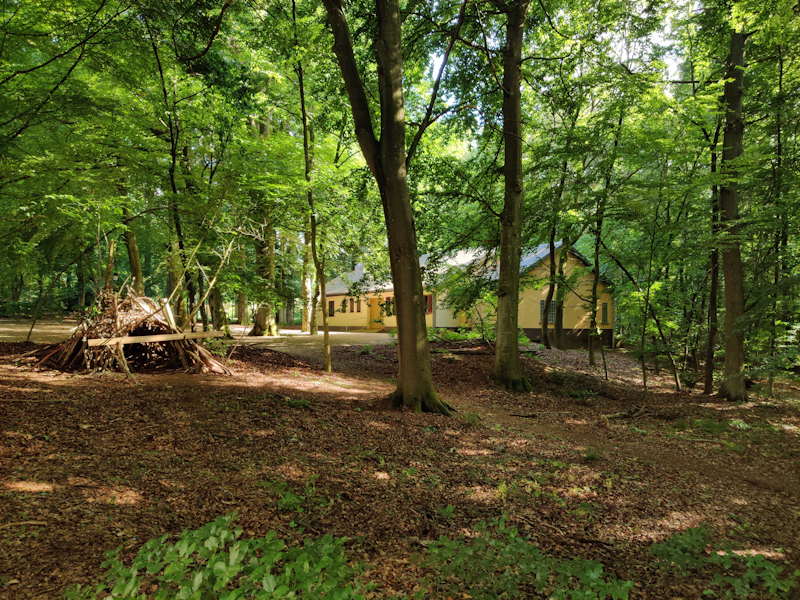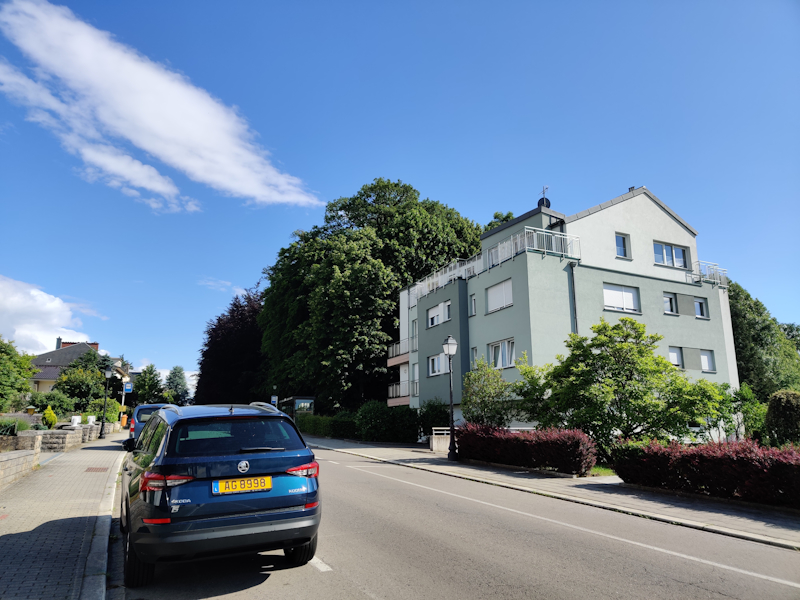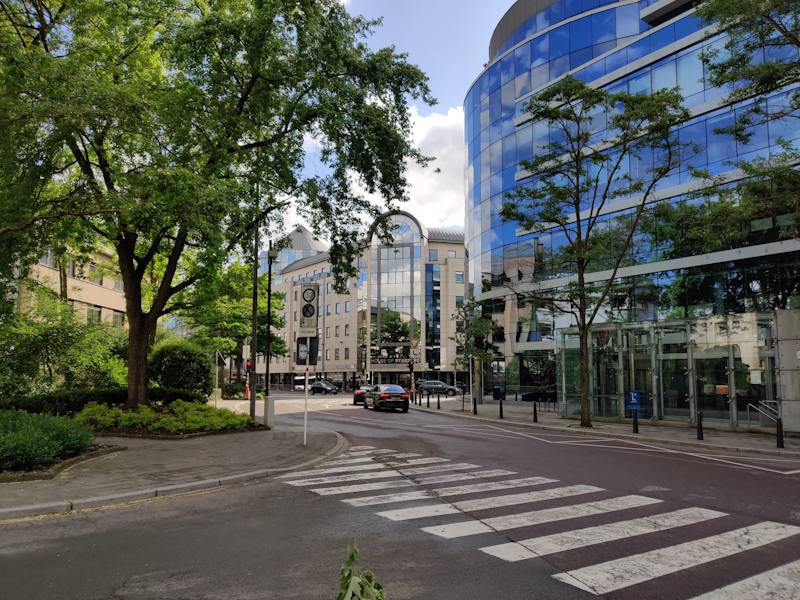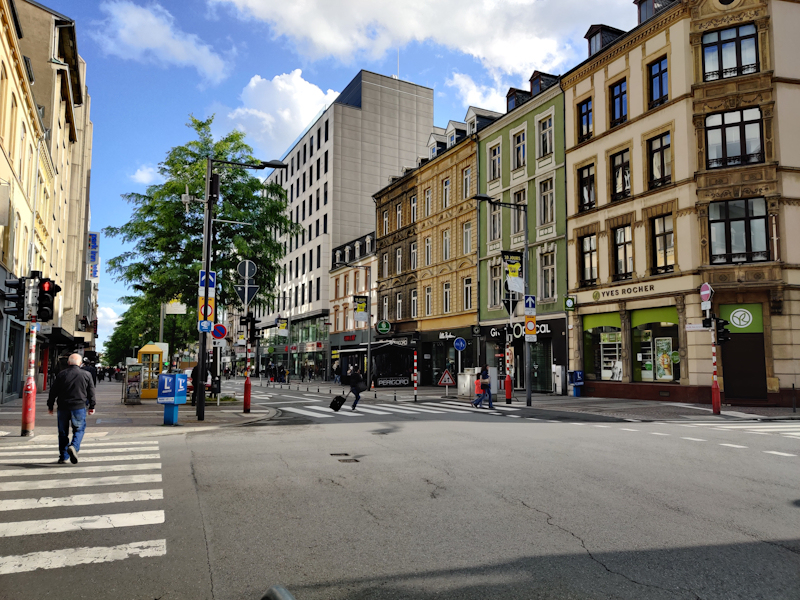The OnePlus 7 Pro Review: Outstanding Performance & Screen, Adequate Everything Else
by Andrei Frumusanu on June 19, 2019 12:00 PM EST- Posted in
- Mobile
- Smartphones
- OnePlus
- OnePlus 7 Pro
Camera - Daylight Evaluation
Having covered the OnePlus 7 Pro’s main feature, the 90Hz screen, the other major selling-point of the phone is its triple-camera setup.
The main camera is a 48MP Sony IMX586 sensor with an f/1.6 aperture lens and OIS. It’s to be noted that OnePlus does one thing right with the new sensor: It largely ignores the 48MP mode and is generally inaccessible besides in the Pro Mode. In general for all intents and purposes this is a 12MP camera shoot, and there’s nothing wrong with that. As we’ve seen reviewed in several other phones over the last year, the sensor’s native resolution capture mode comes with big compromises in terms of dynamic range and in 90% of the cases it’s not something I would recommend users to use.
The wide-angle and telephoto modules on the OP7Pro are also a first for the company, and allows the phone to match the features of the highest end Samsung and Huawei devices. We expect essentially every vendor this year to adopt the triple-camera setup in their flagships, so it’s a must-have in order to compete in the photography department.
Latest Firmware Update as of Writing
Also I have to make a big mention regarding the firmware version this review was written on: Initially I had already completed a camera testing round on the 9.5.5 firmware when I had received the phone, but then OnePlus had released the new OxygenOS 9.5.7 version which had major changes in the camera processing department as well as updating the Nightscape mode with a new improved algorithm, so I've redone the whole camera testing on the new firmware.
This review is also done with Samsung’s latest May firmware update on the Exynos S10 variant which also has major improvements, and coincidentally Huawei had also pushed a big update for the P30Pro which in turn also says to have improved camera performance.
It’s a bit annoying for us reviewers as camera performance is a continuously changing aspect of a new phone following its release (It’s one of the very last things OEMs spend development time on), but hopefully this review gives readers a good representative evaluation of what to expect of the phones for the rest of the year, including the new OnePlus 7 Pro.

[ OnePlus 7 Pro ] - [ OnePlus 6T ]
[ S10+ (E) ] - [ S10+ (S) ]
[ P30 Pro ] - [ Honor 20 Pro ]
[ G8 ] - [ Oppo Reno ]
[ Pixel 3 ] - [ Pixel 3a ] - [ iPhone XS ]
In the first scene there’s a lot of detail and high natural dynamic range as it was a clear day with the sun shining, while also having a lot of darker shadows in the scene.
The OP7Pro does a good job in terms of exposure and composition, however we do notice it lags behind the S10 in ability to capture the true brightness of the scene as well as the more natural saturation of the greenery.
I included the Honor 20 Pro into this review purposely because it has the very same IMX586 sensor as the OnePlus 7 Pro, with the differences between the two phones being that one is running on the Snapdragon 855 and the other is using the Kirin 980 chipset. Naturally each vendor’s camera calibration will also come into play here. This also applies to the Oppo Reno, again using the same popular sensor.
Unfortunately for the OP7Pro, the H20Pro has notably better colours and better HDR, something particularly visible on the highlights of the large hedges. The OnePlus tends to flatten things too much. The shadow captures also remind one very much of the Pixel 3, although it’s not quite as terrible as on the Google phone; here the S10 and iPhone XS’s dynamic range is just much better. OnePlus’ cousin the Oppo Reno also seems to have better handling of details throughout the scene as it’s not washing textures out as much.
We see about the same differences in the wide-angle lens of the OP7Pro: The composition is good, however things are flattened out too much as textures are washed out compared to other phones with wide-angle modules (Well, besides LG), albeit we are talking about different sensors this time around.

[ OnePlus 7 Pro ] - [ OnePlus 6T ]
[ S10+ (E) ] - [ S10+ (S) ]
[ P30 Pro ] - [ Honor 20 Pro ]
[ G8 ] - [ Oppo Reno ]
[ Pixel 3a ] - [ iPhone XS ]
This next scene was actually a bit shocking to me when I was sorting the pictures as I couldn’t believe just how many phones outright failed to get acceptable results. This was actually a sunny day with intermittent cloud cover, and the scene in question was overcast by a larger cloud during the captures. The background clouds however were extremely bright and I think a lot of phones failed because of this.
The OnePlus 6T’s result was particularly potato-quality as its HDR algorithm decided to get rid of all intensity levels beyond 75% luminosity. Overall I find it quite a pity with what OnePlus had done with the 6T as I deemed the OP6 last year to be among the best daytime cameras out there.
Nevertheless, this is about the 7 Pro, and here the new phone does a lot better than the 6T and it manages to get a reasonable exposure. Still it’s not really enough to keep up with the competition as the scene is too dark and the shadows in particularly are artificially too pronounced. The Exynos S10 fell flat when it came to colours, leaving the Snapdragon S10 as the only phone with a good representation of the scene, even if the background sky was blown out.
The wide-angle on the OP7 Pro is good, although again it’s having too dark shadows and the colour temperature is also slightly too warm. What’s interesting here is that in terms of viewing angle, the OP7 Pro is similar to other phones such as the H20Pro, Reno and G8, however the OnePlus has a massively more pronounced distortion on the lens, as seen by the curvature of the ledge at the bottom of the screen.
I found the zoom lens of the OP7 Pro here to be quite excellent. The 3x effective factor results in extremely sharp images throughout the scene, and although the exposure wasn’t challenging here, it was very good.

[ OnePlus 7 Pro ] - [ OnePlus 6T ]
[ S10+ (E) ] - [ S10+ (S) ]
[ P30 Pro ]
[ Honor 20 Pro ] - [ G8 ]
[ Oppo Reno ]
[ Pixel 3 ] - [ Pixel 3a ] - [ iPhone XS ]
The next scene is also an excellent showcase how having the same sensor doesn’t really mean too much in terms of the resulting picture: The OP7Pro, H20Pro and Reno have absolutely nothing in common in terms of the end image.
The picture’s histograms between the OP7Pro and Pixel 3 are shockingly similar, with both phones ending up with similar compositions. However they’re both too dark and wrong colour temperature (The 6T does much better here). The Galaxy S10 is the best representation of the actual scene.

[ OnePlus 7 Pro ] - [ OnePlus 6T ]
[ S10+ (E) ] - [ S10+ (S) ]
[ P30 Pro ] - [ Honor 20 Pro ]
[ G8 ] - [ Oppo Reno ]
[ Pixel 3 ] - [ Pixel 3a ] - [ iPhone XS ]
The next scene is a lot easier in terms of exposure and the OP7Pro ends up with a good composition. Its weaknesses is again similar to that of the Pixel 3 and older phones in that it doesn’t have any dynamic range in the shadows for what is essentially broad daylight.
The Honor 20 Pro showcases that the sensor is able to capture a lot more, and also it doesn’t wash out textures as seen on the OnePlus phone in the road, sidewalk and building façade.

[ OnePlus 7 Pro ] - [ OnePlus 6T ]
[ S10+ (E) ] - [ S10+ (S) ]
[ P30 Pro ] - [ Honor 20 Pro ] - [ G8 ]
[ Oppo Reno ] - [ Pixel 3 ] - [ Pixel 3a ] - [ iPhone XS ]
Continuing on a relatively bad streak, this next scene also isn’t too kind to the OP7Pro. Here it’s actually the 6T which best showcases the 7Pro’s lackings in terms of texture detail as well as shadow exposure. The Honor 20 Pro and Reno both again showcase the hardware should be able to achieve better.
The wide-angle here is good, although again lacking in shadows. It’s at least nice to see that OnePlus’ processing between the main and wide-angle is extremely similar with little to no difference in the vast majority of scenarios, so that’s a plus.

[ OnePlus 7 Pro ] - [ OnePlus 6T ]
[ S10+ (E) ] - [ S10+ (S) ]
[ P30 Pro ] - [ Honor 20 Pro ]
[ G8 ] - [ Oppo Reno ]
[ Pixel 3 ] - [ Pixel 3a ] - [ iPhone XS ]
This last every-day scene again showcases the OP7Pro’s tendency to seemingly destroy shadows and the best example of this is the 6T. Even though the 6T has its own issues here such as flattening highlights too much, it’s able to accurately portray the shop fronts while the OP7 tends to almost clip to black (And actually does so).
The wide angle here did some quite aggressive HDR and brought down the sun-lit foreground street to almost the same levels as the shadow cast parts, something the P30 Pro also erroneously decided to do.
The telephoto module here again performed excellently, resolving a fantastic amount of detail at this magnification level. The only odd thing is that the saturation intensities are quite low, and elements such as the “Coolcat” shop logo ended up completely muted compared to all other phones’ telephoto modules.

[ OnePlus 7 Pro ] - [ OnePlus 6T ]
[ S10+ (E) ] - [ S10+ (S) ]
[ P30 Pro ] - [ Honor 20 Pro ]
[ G8 ] - [ Oppo Reno ]
[ Pixel 3 ] - [ Pixel 3a ] - [ iPhone XS ]
Finally this last scene is just a hard task for any phone and simply a test of the raw dynamic range of the phones; taking a picture against the sun.
The OP7Pro still manages to get good black points in post-processing, although doesn’t match Huawei or Samsung in terms of dynamic range. Oddly enough the phone’s wide-angle achieves a lot better results here.
The telephoto also does very well in prioritising the actual scene, as opposed to the dark shots of the P30Pro and Honor 20 Pro.
Daylight Camera Conclusion
Overall, I was relatively disappointed by the OnePlus 7 Pro’s daylight capture performance. Having the Honor 20 Pro and the Oppo Reno in this camera comparison has showcased that this isn’t inherently an issue of the camera’s hardware and the Sony IMX586 sensor, but rather something on the part of OnePlus’ camera calibration and post-processing algorithms.
The two most egregious issues with the main camera sensor shot is the fact that OnePlus tends to wash out textures a lot more, and that it gives too little priority to shadows. The first issue is actually quite bad in some cases as we’ve had some shots in which the OnePlus 6T actually fared better.
The issue of the dark and even clipped shadows reminds me a lot of the Pixel’s processing. I do really hope that OnePlus wasn’t trying to mimic Google’s processing here and that this is just an issue of the exposure algorithms rather than an intentional post-processing effect in order to add contrast to the pictures. I was never impressed by this part of the Pixel’s camera and is easily the single worst aspect for OnePlus to have in common with.
The wide-angle module, much like on other phones, is an outstanding addition to the capture experience of the phone. In terms of actual picture results, it shares the same processing issues as the main camera. While this is to expected of a wide-angle module, the chromatic aberrations and distortions on the very edges of the frame are exceptionally pronounced on the OP7Pro, pointing out to rather low quality optics.
Finally, I didn’t have any major issues with the new 3x telephoto lens. I was actually quite impressed by the detail the module was able to resolve, and I don’t feel it has as many processing issues as the other two modules.
Overall, whilst the OnePlus 7 Pro’s camera in daylight isn’t outright bad, it really can’t claim it’s a flagship killer as it gets bested by a lot of phones, including from Huawei, Honor, Samsung.










91 Comments
View All Comments
RSAUser - Wednesday, June 19, 2019 - link
Didn't they release a day one software fix for this? Remember reading something about it.XabanakFanatik - Wednesday, June 19, 2019 - link
I have not seen any attempts to fix this, and I have checked after every update (two so far since launch day) to see if it is fixed.It is not yet resolved.
Dorkaman - Sunday, June 30, 2019 - link
Hi Xaban this is bad news. I guess I'll wait for a phone with 120Hz display. 120Hz divides cleanly with 24, 30 and 60 so videos with those numbers should be smooth.packers - Monday, July 8, 2019 - link
Great Article!I read your Article. Thanks for sharing with us.https://www.shiftinindia.com/
Kishoreshack - Wednesday, June 19, 2019 - link
Has anyone observed color shifting on curve edges?The Curve in display should not be overwhelming.
Except for Note 9 I have seen that in most Curved displays
The amount of curvature given to the display needs to be in limit
I think the abysmal White Balance of Pictures taken needs to be addressed
&
Even the variable refresh rate of screen needs to be upgraded in line with Apples
Don't think so it would be that tough to do that
warreo - Wednesday, June 19, 2019 - link
There is definitely color shifting on my OP7P, especially at the curves. The color shift in general is notably worse than on my Pixel 3, which interestingly was an LG panel vs. Samsung on the OP7P.That said, it's not Pixel 2 XL level bad, which was flat out terrible. I couldn't accept the P2XL's shift and returned it. My OP7P is acceptable and I've been really happy with the phone, mediocre camera and all.
s.yu - Wednesday, June 19, 2019 - link
I wonder if one could drill a hole in the frame and add a 3.5mm port through jump wire or something.melgross - Wednesday, June 19, 2019 - link
Oh, just get over it.Lord of the Bored - Wednesday, June 19, 2019 - link
NEVER!rohitghali - Sunday, October 13, 2019 - link
The only reason I'm not buying this phone is the jack.